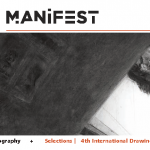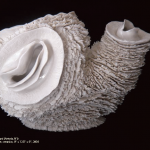Curated by Tim Parsley
What role does story play in a society that seems increasingly defined by production, laws, budgets,
and CNN sound bites? For some, story is the luxury of childhood; packed away with toy gun holsters
and ballerina outfits when we head off into the “real-world” of adulthood. If story stays with us into
maturity, it is often regulated to the realm of “escape” or hobby – something to enjoy or find interest in
only once deadlines are met, clients are satisfied, dishes are washed and put away. Yet society still
finds solace, maybe desperately so, in blockbuster films and TV series, allowing them to indulge their
need for story.
Artists of different stripes have known that stories are vessels of meaning. Often fiction can be truer
than the facts. The imaginative helps us to see more clearly. How many of us, when hearing a tale
told well – whether through film, novel, or just a friend sharing a personal experience – have not felt
the resonance of connection with that story? While we may not share the particulars of the tale,
something corresponds with our experience – or calls us out from our experiences – and widens our
view, deepens our understanding, and locates our sense of being.
Mythography: An Exploration of Narrative exhibits the work of 13 artists who still believe in the
potency of story. While many of these works are elusive in meaning (as many good stories are), they
take on new layers of meaning when displayed alongside each other (we might say, they resonate
and deepen with each other). Some of the stories find their strength in archetypal narratives that have
defined entire civilizations while others are more personal, memoir-ish, giving the viewer a glimpse
into the private experience of the Other. Eve makes an appearance, though in vari ous guises in the
works of Jessica Grace Bechtel, Joseph Miller, and the sensuously delicate sculpture of Noriko
Kuresumi. History has a chapter as well: fragmented, re-pieced, and manipulated together in the
films of Bill Domonkos and the weathered book of photographs by Laura Fisher. Boats, descending
stairwells and flying blimps invite us to take a journey, to explore, to travel to lands unknown.
In the wake of Modernism’s insistence that art need only refer to itself, the works in Mythography
unashamedly take us somewhere else. Shirking Modernism’s academic dismissal of the narrative as
merely illustrative, they operate as windows into other realities. Consequently, Mythography offers us
another page in the various chapters being written after the story of Modernism, reminding us that
while surface carries its own important content, so much art made today goes beyond a dogmatic
attachment to the eminence of form.
People need stories. While Manifest is firmly committed to a broad range of artistic approaches, we
are proud to offer this distinct contribution to the telling of tales by visual artists and further fulfill our
mission of creating quality-centered experiences for the viewing public.

 Posted on 3月 6, 2009
Posted on 3月 6, 2009
 by SO
by SO  0
0 
